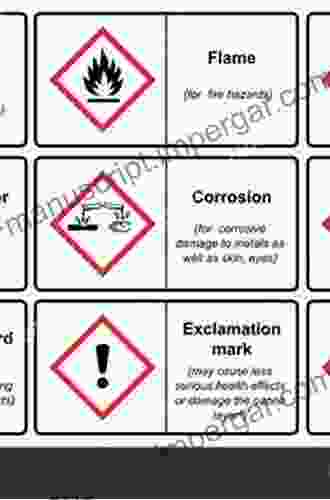Unlocking Chemical Safety: The Globally Harmonized System of Classification and Labelling of Chemicals (GHS)

In an increasingly globalized world, ensuring the safe handling and use of chemicals is paramount. The Globally Harmonized System of Classification and Labelling of Chemicals (GHS) stands as a cornerstone in this endeavor, providing a standardized framework for classifying and labelling chemicals hazard information worldwide.
4.9 out of 5
| Language | : | English |
| File size | : | 38428 KB |
| Text-to-Speech | : | Enabled |
| Screen Reader | : | Supported |
| Enhanced typesetting | : | Enabled |
| Word Wise | : | Enabled |
| Print length | : | 1 pages |
Origins and Purpose
The GHS emerged from a growing recognition of the need for a harmonized approach to chemical safety. Prior to its adoption, different countries employed varying systems for classifying and labelling chemicals, leading to confusion and inconsistencies in safety information.
To address this, the United Nations Economic Commission for Europe (UNECE) initiated the development of the GHS. The goal was to create a single, standardized system that would facilitate international trade, improve worker protection, and enhance public safety.
Key Elements of GHS
The GHS comprises several key elements:
1. Classification of Chemicals
GHS establishes criteria for classifying chemicals based on their inherent hazards. These hazards include physical hazards (e.g., flammability, explosiveness),health hazards (e.g., toxicity, carcinogenicity),and environmental hazards (e.g., aquatic toxicity).
2. Label Elements
The GHS specifies standardized label elements that must be included on chemical containers. These elements include:
- Pictograms: Universal symbols that graphically represent the hazards of the chemical.
- Signal words: Words like "Danger" or "Warning" that indicate the severity of the hazard.
- Hazard statements: Phrases that describe the specific hazards of the chemical.
- Precautionary statements: Instructions on how to safely handle and use the chemical.
3. Safety Data Sheets (SDSs)
GHS requires the creation of Safety Data Sheets (SDSs) for all hazardous chemicals. SDSs provide detailed information about the chemical's properties, hazards, and safe handling practices.
Implementation and Impact
The GHS has been widely adopted globally. As of 2022, over 70 countries and jurisdictions have implemented the system. This has led to significant improvements in:
1. International Trade
GHS has facilitated international trade by harmonizing chemical classification and labelling requirements. This has reduced confusion and delays at customs, and has promoted greater transparency and consistency in the global chemical market.
2. Worker Protection
GHS has enhanced worker protection by providing clear and consistent hazard information on chemical labels and SDSs. This has enabled workers to make informed decisions about how to safely handle and use chemicals, reducing the risk of accidents and occupational diseases.
3. Public Safety
GHS has contributed to public safety by providing consumers with readily accessible information about the hazards of household chemicals. This has empowered consumers to make informed choices about the products they use, and has helped prevent accidents and injuries.
The Globally Harmonized System of Classification and Labelling of Chemicals (GHS) has revolutionized the way we communicate chemical hazards worldwide. By providing a standardized framework for classifying, labelling, and documenting chemical safety information, GHS has significantly enhanced international trade, worker protection, and public safety.
As the chemical industry continues to evolve, GHS will remain an essential tool for ensuring the safe handling and use of chemicals, protecting both human health and the environment.
4.9 out of 5
| Language | : | English |
| File size | : | 38428 KB |
| Text-to-Speech | : | Enabled |
| Screen Reader | : | Supported |
| Enhanced typesetting | : | Enabled |
| Word Wise | : | Enabled |
| Print length | : | 1 pages |
Do you want to contribute by writing guest posts on this blog?
Please contact us and send us a resume of previous articles that you have written.
 Book
Book Novel
Novel Page
Page Chapter
Chapter Text
Text Story
Story Genre
Genre Reader
Reader Library
Library Paperback
Paperback E-book
E-book Magazine
Magazine Newspaper
Newspaper Paragraph
Paragraph Sentence
Sentence Bookmark
Bookmark Shelf
Shelf Glossary
Glossary Bibliography
Bibliography Foreword
Foreword Preface
Preface Synopsis
Synopsis Annotation
Annotation Footnote
Footnote Manuscript
Manuscript Scroll
Scroll Codex
Codex Tome
Tome Bestseller
Bestseller Classics
Classics Library card
Library card Narrative
Narrative Biography
Biography Autobiography
Autobiography Memoir
Memoir Reference
Reference Encyclopedia
Encyclopedia Dr Guinevere Stasio
Dr Guinevere Stasio Christian Peak
Christian Peak Christine Wilding
Christine Wilding Ole Thorstensen
Ole Thorstensen Michael Rizzo
Michael Rizzo Gay Talese
Gay Talese Christine Brown
Christine Brown Charlie Gilmour
Charlie Gilmour Susan Lee Smith
Susan Lee Smith Ramaji
Ramaji John Retallack
John Retallack Valorie Burton
Valorie Burton Michael T Gamble
Michael T Gamble Kevin Metcalf
Kevin Metcalf Christian Jacq
Christian Jacq Himanee Gupta Carlson
Himanee Gupta Carlson Chris Dumas
Chris Dumas Christopher Zyda
Christopher Zyda Charles Smith
Charles Smith Christian D Larson
Christian D Larson
Light bulbAdvertise smarter! Our strategic ad space ensures maximum exposure. Reserve your spot today!
 Cormac McCarthyFollow ·13.9k
Cormac McCarthyFollow ·13.9k Cody RussellFollow ·9.1k
Cody RussellFollow ·9.1k Ross NelsonFollow ·2.6k
Ross NelsonFollow ·2.6k Elliott CarterFollow ·12.1k
Elliott CarterFollow ·12.1k Andy ColeFollow ·15k
Andy ColeFollow ·15k Jaden CoxFollow ·2.7k
Jaden CoxFollow ·2.7k Edwin BlairFollow ·2.6k
Edwin BlairFollow ·2.6k Wayne CarterFollow ·14.6k
Wayne CarterFollow ·14.6k

 E.E. Cummings
E.E. CummingsOne Man's Story of What It Meant to be Pj
In the tapestry of life,...

 Caleb Long
Caleb LongPattern Theory in Video Keno: Unveiling the Art of...
Embark on an enlightening journey into the...

 Douglas Adams
Douglas AdamsUnveiling the Diplomatic Landscape: The Ottoman Empire,...
Delving into the History...

 Terry Bell
Terry BellThere Still Is No Off Season: Embracing Year-Round...
In a world consumed by routine and the allure...

 Ibrahim Blair
Ibrahim BlairBrain Teasers Games and Puzzles: Exercise Your Mind with...
Prepare to embark on a captivating journey...
4.9 out of 5
| Language | : | English |
| File size | : | 38428 KB |
| Text-to-Speech | : | Enabled |
| Screen Reader | : | Supported |
| Enhanced typesetting | : | Enabled |
| Word Wise | : | Enabled |
| Print length | : | 1 pages |













